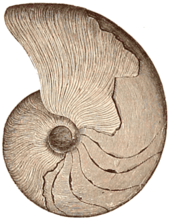Orthoceras
Orthoceras ("straight horn") is a genus of extinct nautiloid cephalopod restricted to Middle Ordovician-aged marine limestones of the Baltic States and Sweden.[1] This genus is sometimes called Orthoceratites. Note it is sometimes misspelled as Orthocera, Orthocerus or Orthoceros (Sweet 1964:K222).
| Orthoceras | |
|---|---|
 | |
| Artist's reconstruction of O. regulare | |
| Scientific classification | |
| Kingdom: | Animalia |
| Phylum: | Mollusca |
| Class: | Cephalopoda |
| Order: | †Orthocerida |
| Family: | †Orthoceratidae |
| Genus: | †Orthoceras Bruguière, 1789 |
| Species | |
| |
Orthoceras was formerly thought to have had a worldwide distribution due to the genus' use as a wastebasket taxon for numerous species of conical-shelled nautiloids throughout the Paleozoic and Triassic. Now, Orthoceras sensu stricto refers to O. regulare, of Ordovician-aged Baltic Sea limestones of Sweden and neighboring areas.[1]
These are slender, elongate shells with the middle of the body chamber transversely constricted, and a subcentral orthochoanitic siphuncle. The surface is ornamented by a network of fine lirae (Sweet 1964:K224). Many other very similar species are included under the genus Michelinoceras.
History of the name
Originally Orthoceras referred to all nautiloids with a straight-shell, called an "orthocone" (Fenton & Fenton 1958:40). But later research on their internal structures, such as the siphuncle, cameral deposits, and others, showed that these actually belong to a number of groups, even different orders.
According to the authoritative Treatise on Invertebrate Paleontology, the name Orthoceras is now only used to refer to the type species O. regulare (Schlotheim 1820) from the Middle Ordovician of Sweden and parts of the former Soviet Union such as Russia, Ukraine, Belarus, Estonia and Lithuania.[1] The genus might include a few related species.
Confusion with Baculites
Orthoceras and related orthoconic nautiloid cephalopods are often confused with the superficially similar Baculites and related Cretaceous orthoconic ammonoids. Both are long and tubular in form, and both are common items for sale in rock shops (often under each other's names). Both lineages evidently evolved the tubular form independently of one another, and at different times in earth history. Orthoceras lived much earlier (Middle Ordovician) than Baculites (Late Cretaceous). The two types of fossils can be distinguished by many features, most obvious among which is the suture line: simple in Orthoceras (see image), intricately foliated in Baculites and related forms.
See also
References
- Paleontological Institute. "Part K, Mollusca 3". Treatise on Invertebrate Paleontology. Archived from the original on 3 March 2016. Retrieved 5 December 2013.
- Fenton, C. L.; Fenton, M. A. (1958), The Fossil Book, Doubleday & Co., Garden City, New York
- Sweet, Walter C. (1964), Nautiloidea -- Orthocerida, in Treatise on Invertebrate Paleontology. Part K. Mollusca 3, Geological Society of America, and University of Kansas Press, New York, New York and Lawrence, Kansas
